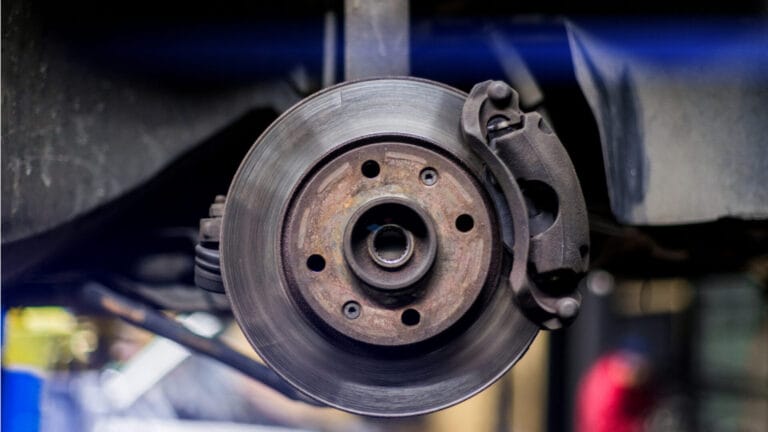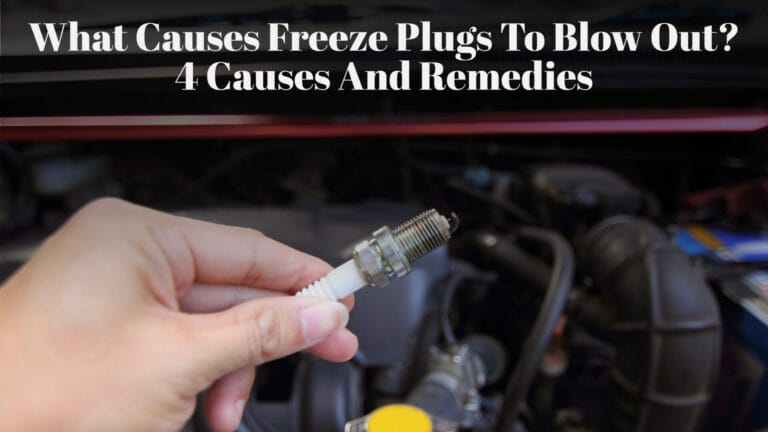Can Rotors Cause Vibration Without Braking
Driving is more than just getting from point A to point B; it’s about the experience of smooth, enjoyable journeys. But what if that smooth ride is disrupted by an unexpected vibration, even when you’re not tapping the brakes? Could it be the innocent rotors? Can rotors cause vibration without braking?
You caught it right;
Yes, rotors can cause vibration without braking, and the phenomenon at play here is called rotor runout.
Rotor runout occurs when the brake rotor isn’t perfectly flat and parallel to the brake pads, causing it to do a little dance ( imbalance) as it rotates. This uneven surface makes contact with the brake pads, resulting in a car shake when the vehicle is in motion, turning your smooth drive into a shaky and uncomfortable experience.
It’s like a wobbly dinner plate at a fancy party. And there might be some strange noises, too—squeaks or grinds joining the party at higher speeds or during acceleration.

Fear not; I am your go-to friend in this guide to shed light on this automotive mystery. We will explore everything you need to know about brake rotors, the science behind their vibrations, signs of faulty rotors, potential causes, and solutions to fix the issue before it gets worse.
So, let’s rev up our engines and get ready to demystify the world of vibrating rotors!
- Understanding Brake Rotors and Their Function
- What Causes Brake Rotor Runout?- Let’s fix them
- Signs of Faulty Rotors Causing Car Vibration Without Braking
- Possible Causes of Vibration without Braking (leaving rotor)
- The Role of Driving Conditions Causing Vibration
- Can A Bad Brake Caliper Cause Vibration?
Understanding Brake Rotors and Their Function
Brake rotors, also known as discs brake are typically made of cast iron or composite materials and are designed to withstand high levels of heat and friction. As you press down on the brake pedal, brake calipers and pads work hand in hand. From the master cylinder, brake fluid is pumped to the caliper, converting kinetic energy into thermal energy to generate the force needed to bring your vehicle to a halt.
What Causes Brake Rotor Runout?- Let’s fix them
Brake rotor runout might sound like automotive jargon, but it’s the reason your once serene drive can turn into an unplanned dance party for your car. Ever wondered what causes this runout, leading to vibrations without even tapping the brakes? It’s not just one thing; rather, a mix of factors contributes to the uneven rotor surface and the subsequent vibrations. Understanding these dance partners can save you from the vibrations that disrupt your driving zen.

Now, let’s dive into the primary culprits and find ways to prevent or fix them.
Wear and Tear
Wear and tear on brake rotors over time can lead to rotor runout. As you use your brakes, the friction material on the rotor creates uneven surfaces. This wear and unevenness result in thickness variations around the rotor face.
When the rotor spins, these variations induce imbalance, causing the rotor to wobble. This wobbling leads to brake vibration transmitted through the vehicle, felt in the steering wheel or brake pedal.
Solution
Regular maintenance and timely rotor replacement are essential to prevent this chain reaction and maintain a smooth driving experience
Heat and Stress
When you slam on the disc brakes, things get hot. The brake rotor takes a hit from the heat and stress, especially during quick stops or downhill rides. This heat can make the brake rotor warp, causing it to have bumps and uneven spots. When the rotor spins, these bumps make it wobble, creating too much heat and stress that mess with the rotor, making your car vibrate.
Solution
Avoid hard braking and aggressive stops to reduce the heat generated. Consider high-quality brake components designed to handle heat more efficiently.
Improper Lug Nuts Torquing
Improper torquing of lug nuts, especially in a random way, messes with your brake rotor, causing uneven pressure distribution. As a result, the rotor gets bumps and grooves, causing the warped brake rotor.
Solution
Follow the recommended torque specifications and tighten lug nuts in a star-pattern sequence to ensure even pressure distribution. It’s like giving your car’s dance moves a proper rhythm.
Uneven Brake Pad Deposits
When brake pads are not properly bedded in or if they are subjected to excessive heat, uneven pad deposits can form on the rotor surface. These brake pad materials can cause the rotor to become uneven and out of balance, resulting in vibrations when the brakes are applied.
Solution
Adopt smooth and gradual braking habits at highway speed to minimize uneven material transfer. Regularly clean and service brake components to maintain a consistent surface.
Low-Quality Brake Components
Low-quality brake components, including slotted rotors, may exhibit uneven wear, making things worse. If your brakes aren’t made with precision, your rotor bears the brunt. These components struggle to endure the heat generated during braking and face challenges in efficient cooling, resulting in heightened stress. This stress can lead to premature warping and the dreaded runout.
Solution
Make a wise investment in high-quality brake components designed to withstand the intense heat and stress of braking, ensuring a longer lifespan.
Improper Rotor Installation
When the rotor is not installed correctly, it may not perfectly align with the wheel hub. This misalignment can result in uneven contact between the rotor and brake pads, causing the rotor to wobble or “run out” during braking.
Solution
When servicing or replacing brake systems, ensure new rotor installation and alignment are done as per manufacturer guidelines using the right tools. It’s better to take it to an auto repair shop or call for a skilled mechanic.
Understanding these factors helps car enthusiasts take proactive measures to prevent rotor runouts. Regular maintenance, proper braking habits, and the use of high-quality brake components can significantly contribute to a smoother and more enjoyable driving experience.
Signs of Faulty Rotors Causing Car Vibration Without Braking
If you are not sure rotors are the sneaky culprit causing your car to vibrate even when you’re not hitting the brakes, here are signs to watch for:

- If your steering wheel has a mind of its own, vibrating without warning, it could be a signal of rotor troubles.
- You might sense your whole car vibrating, especially at certain speeds, as if it’s marching to its own beat.
- Listen for unusual sounds, like a low hum or a rhythmic thumping, which can indicate bad rotor issues.
- Faulty rotors can lead to uneven tire wear, affecting the balance of your wheels at high speed and contributing to brake pedal pulsation.
- Your car may drive smoothly one moment and then start vibrating unexpectedly, indicating an underlying rotor problem.
If you experience any of these symptoms, it’s wise to get your slotted rotor checked. Remember, a little attention now can keep your ride smooth and enjoyable down the road.
Possible Causes of Vibration without Braking (leaving rotor)
Vibrations in a vehicle without braking can be attributed to various underlying issues. Let’s delve into the other causes leaving, rotor so we can at least understand what the culprit is for this problem. By understanding these causes, you’ll be better equipped to address and rectify the issue, ensuring a smoother and more enjoyable driving experience.”

Uneven Tire Wear
Uneven tire wear can result from issues like misalignment, improper tire inflation, bent rim, or suspension problems. When tires wear unevenly, it can lead to imbalances in the wheel assembly, causing vibrations.
Wheel Imbalance
Unbalanced wheels can generate vibrations, even in the absence of braking. This imbalance can stem from uneven tire wear, a lost wheel weight, or improper wheel installation.
Suspension Issues
Worn-out or damaged suspension components, such as struts, shocks, or bushings, can contribute to vibrations. A compromised suspension system is less effective at absorbing road shocks, leading to vibrations transmitted to the vehicle.
Driveshaft or CV Joint Problems
Issues with the driveshaft or constant velocity (CV) joints can cause vibrations, especially during acceleration. Worn or damaged components in the driveshaft or CV joints may lead to imbalances and unwanted vibrations.
Engine Issues
Engine problems, such as misfires, faulty motor mounts, or irregular idling, can manifest as vibrations. The engine is a crucial part of the overall vehicle balance, and any disruptions in its performance can lead to vibrations.
Transmission Issues
Problems within the transmission, such as worn-out or damaged mounts, can result in vibrations. An unstable transmission can transmit vibrations throughout the vehicle.
Wheel Bearing Failure
Worn or damaged wheel bearings can cause vibrations, especially at certain speeds. When wheel bearings wear out, the wheel assembly becomes less stable, leading to vibrations.
Axle Issues
Damaged or bent axles can contribute to vibrations, affecting the smooth rotation of the wheels. Axle issues can result from accidents, rough driving conditions, or wear over time.
If you experience persistent vibrations, it’s advisable to consult with a qualified mechanic to diagnose and address the underlying issues promptly. Regular maintenance and timely repairs contribute to a smoother and more enjoyable driving experience.
The Role of Driving Conditions Causing Vibration
Driving conditions, including braking habits, terrain, and weather, play a significant role in the wear and tear of brake components and the vehicle’s suspension. Factors such as frequent braking, high speeds, and aggressive driving can accelerate rotor wear, potentially leading to vibration concerns.

Additionally, wet, icy, or uneven road surfaces can contribute to rotor wear and the onset of potential vibration issues. By considering the impact of driving conditions on rotor health and aligning maintenance practices, you can mitigate the vibration risk and ensure optimal performance.
Can A Bad Brake Caliper Cause Vibration?
Yes, a malfunctioning brake caliper can cause vibrations in your vehicle. When a brake caliper is faulty or sticking, it can cause uneven pressure on the brake pads and rotor. This imbalance creates a pulsating sensation in the brake pedal, which you’ll feel as vibrations when you apply the brakes. Not only is this annoying, but it can also be a safety hazard if left unchecked.
So, if you’re experiencing vibrations, immediately have your brake calipers inspected and repaired by a professional mechanic.
FAQ
Can Rotors Make Noise When Not Braking?
Yes, rotors can make noise even when you’re not braking. Rotors making sound is a sign of a faulty rotor. Uneven surfaces, loose components, or issues with the wheel hub or bearings may cause these sounds.
Is It Safe To Drive A Car With A Warped Rotor?
No, driving a car with a warped rotor is not safe. Continuing driving with a warped rotor can cause brake system failure and compromise your ability to stop your vehicle safely in emergencies.
Can Brakes Cause Vibration At High Speeds?
Yes, brakes cause vibration at a higher speed. Unevenly worn rotor, heat buildup, or brake pad issues can be the reason behind it. When you apply the brakes, the brake pads squeeze against the rotor to slow down your vehicle. Over time, the rotor can develop uneven wear or small imperfections, which can lead to vibrations when you hit the brakes at higher speeds.
How Do I Know If My Rotors Are Warped?
If your brakes pulse or vibrate, suspect warped rotors. Listen for squeaks or grinds signs of uneven contact. Watch for changes like longer stopping distances or increased pedal pressure. Uneven pad wear or visible rotor damage also indicates you have warped rotors.
Conclusion
While it may seem counterintuitive that a component responsible for braking could cause vibrations when not in use, it’s indeed possible. Over time, rotors can become warped or uneven due to various factors such as heat, wear and tear, or improper installation. This can lead to vibrations being transmitted through the steering wheel or the entire vehicle when driving.
Now that you know in which state the rotor can cause vibration without braking, you should look out for these signs in your car rotor. If you are not good at it, call a professional and do an inspection. Addressing any issues with your rotors promptly can help ensure a smoother and safer driving experience. So don’t ignore those pesky vibrations – get them checked out today!






